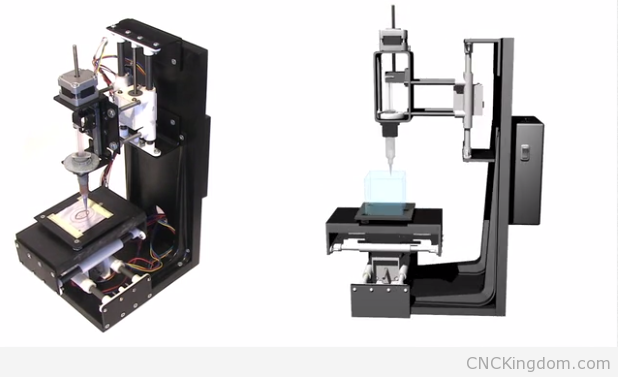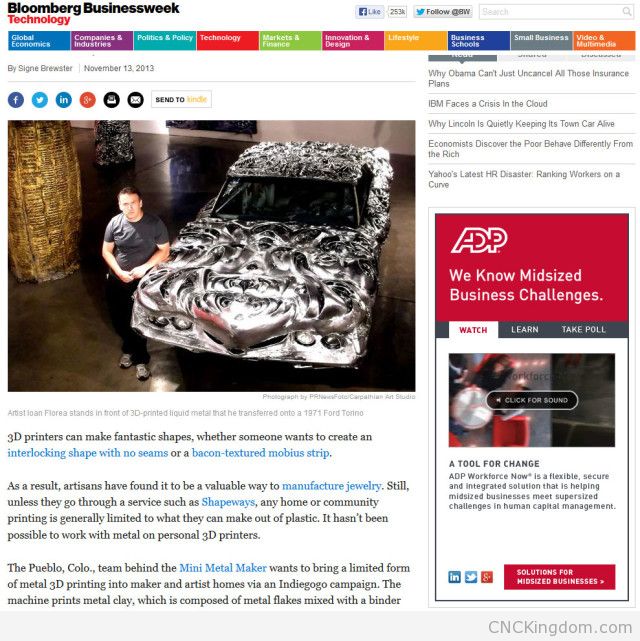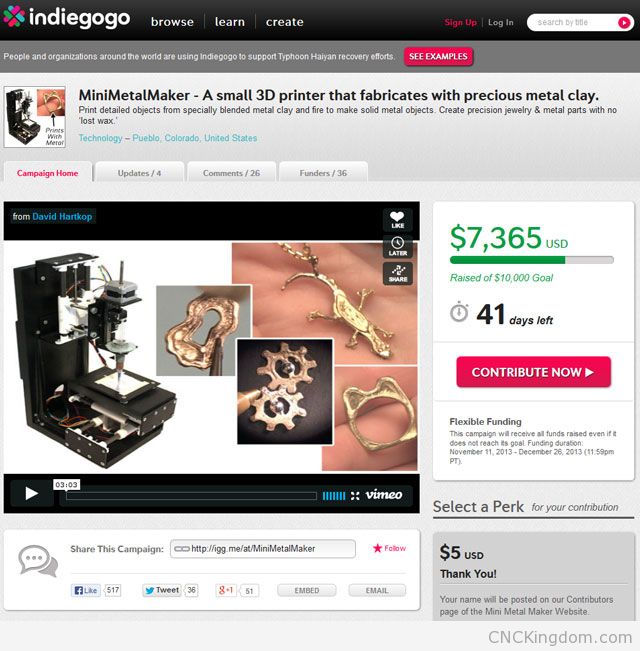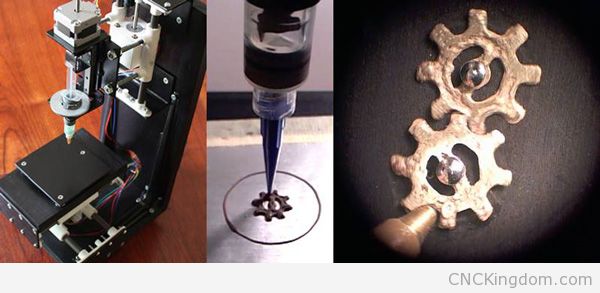Interview with MiniMetalMaker’s David Hartkop (USA)
 There are a lot of 3D printers out there looking for funding but this one caught my eye… it uses metal clay instead of plastic! I contacted David to see if he was interested in talking a bit more about his awesome 3D printer and I’m so happy he agreed!
There are a lot of 3D printers out there looking for funding but this one caught my eye… it uses metal clay instead of plastic! I contacted David to see if he was interested in talking a bit more about his awesome 3D printer and I’m so happy he agreed!
As of this blog, they are 75% of the way towards their goal of 10 000$US funding with 41 days to go! You can help by visiting http://www.indiegogo.com/projects/minimetalmaker-a-small-3d-printer-that-fabricates-with-precious-metal-clay
Can you give me some background about yourself and how you eventually found yourself into 3D printing in general?
I have a background in filmmaking and art. I took a series of jewelry classes in college at Loyola Marymount University in LA, and that’s when I first encountered the university’s 3d printer. It was 1998 and the machine was a huge stratasys the size of a washing machine with a 1mm resolution, but it was still the coolest thing I had ever seen. I had the opportunity to print some objects with this printer and to do a lost-wax casting with them to make metal forms from a 3d object file… awesome. Just awesome, despite all the work it takes to go through the lost wax process. You pretty much need a room full of tools & a couple days to do it.
My project on Indiegogo is really an outgrowth of that time, and my wanting to be able to make more objects directly with metal from digital objects. The new things on the scene now are low-cost robotics and a whole variety of these metal clays… neither of those were around in the 1990s.
I’ve seen A LOT of Kickstarter/indiegogo campaigns for PLA/ABS/resin but this the first for full 3D metal printing. What is it about metal that is more challenging than using plastics?
The challenge is that using metal clay in the context of 3d printing seems to be original! I actually haven’t found anybody else doing it. Which was scary at the start, because most good ideas, it seems, already have a ton of people pursuing them. In this case, it involved bringing together the tools of two very different cultures of people: Metal clay tends to be used by true hand-crafting artisans.

It is a tool for people who wish to make very special organic-shapes in metal. These people are artists & potters sculptors. The 3d printer and maker culture, on the other hand, is rooted in programmer-geekdom with engineering and DIY electronics at its core. To take something that is traditionally only a ‘hands-on’ material and apply it to totally hands-off robotic manufacture is a kind of sacrilege.
The other part is the fact that most 3D printers trend toward bigger build volumes and lower cost print stock. My 3D printer runs counter to both those features, in that I focused instead on a small (2.3 inch cube) build volume with really high resolution, and am using maybe the world’s most expensive feed stock… gold! (or silver, bronze, iron, and a few other types of metals.)
So, was it a risk think people would want a 3D printer in this space with these qualities? Absolutely. It sill is! Fingers crossed…

You’ve achieved some amazing marketing coups like getting in businessweek etc… how did you achieve this? How did it come about?
You’ve got me. I think the fact that anything labeled “3D Printer” is getting news attention right now is certainly helping… but I’m just baffled and AMAZED! It isn’t often one has an idea that is ‘on time’ in the marketing zeitgeist sense… usually ideas come too late or too early for people to want them or ‘get’ them.

What are the advantages to 3D printing in metal over other materials? I saw some awesome examples on your site such as conducting electricity and being able to bend/file output models.
The main advantages are just that the finished product IS metal. It has superior wear properties to many plastics, can bend and hold shape, can be polished to a beautiful luster, etc. Objects made from metal clays are what is referred to as ‘sintered’ meaning made up of welded-together metal particles.
Sintered metals have many uses, but do tend to be a bit more brittle than traditionally cast or foundry-extruded metals. I see the mini metal maker being useful for certain specific engineering/technical applications, and extremely useful to artists and metal artisans.

Can you describe in more detail how you got your team together to design and market the Mini Metal Maker? Why did you all decide to go the crowdfunding route instead of using VCs or angel investors?
My team currently consists of myself, programmer Ben Aiken, and my two friends Tim & Chrissy Sparks. I have been in touch with Ben over the years and have consulted with him on various software related projects.
We saw this as a way we could really collaborate on something interesting. My experience is mostly along the lines of fabrication and ‘mechatronic’ engineering to create solar trackers and coffee roasting equipment for my other business.
Tim and Chrissy have been wonderful in terms of helping me get the word out about the project. We worked together on a previous, though unsuccessful, film project on Kickstarter and learned a lot about social media marketing.
One of the main reasons we went the crowdfunding route vs. VC is that croudfunding not only helps you find project funding, it also puts you in better touch with your target market. It’s amazing how many questions and comments I’ve received, and how many suggestions I hear about what the product ‘should’ do. It’s direct, broad based, and is ultimately going to guide me in making a better product than if I just got all the money from a VC.

Are there any challenges present with storing raw metal clay filaments like there are for PLA/ABS which tends to dry-out or break when exposed to the environment?
So, first of all, metal clay is stored in a tube as a mixed sort of ‘gel’ about the consistency of thick toothpaste. The tubes keep it from drying over time, but there may be issues of long-term storage and the clay separating out more than desired. Chemists and engineers have been developing metal clay for years, though, and most of these problems are well addressed.
I didn’t invent metal clay, I’m just putting it to use in a different way.
You are almost half way though towards achieving your 10K goal – why so little? 3D printing is such an expensive industry… this is such a shoestring budget!
I figured that, since I was able to develop the whole machine this far for under $1K, that I should be able to refine it into something salable for 10, at least something basic and kit-based. If we end up raising more funds than the initial goal, I will be able to create something better than my most basic plans.
This includes a machine with a bigger build volume, two extrude heads, and I’ll be able to do the research needed to produce a good ‘support material’ for use with metal clay when making overhanging shapes.

I see incredible opportunities in 3D metal printing from small industrial processes to jewelry as the alternatives in the market now are exponentially more expensive. How does your Mini Metal Maker compare to the big industrial guys?
Well -and this applies to 3d printing as a whole- I don’ think it will ever compete dollar-for-dollar with large scale industrial production. What 3d printing lets you do is create small volumes of specific things, or individual specialty things that you couldn’t get any other way. An example is that a factory in India produces a metal button for 2 cents each … if I lost one from my coat, however, I might have to order a bag of 500 of them and then wait 3 months to get them… I overpay on the item, the shipping, and on time.
A metal printer, however, would let me just print 1 exactly matching button. Even though it may cost 50 cents and not 2 cents, I actually SAVE money and time because of the accessibility of the manufacture.

Help David get his 10K funding by visiting http://www.indiegogo.com/projects/minimetalmaker-a-small-3d-printer-that-fabricates-with-precious-metal-clay
